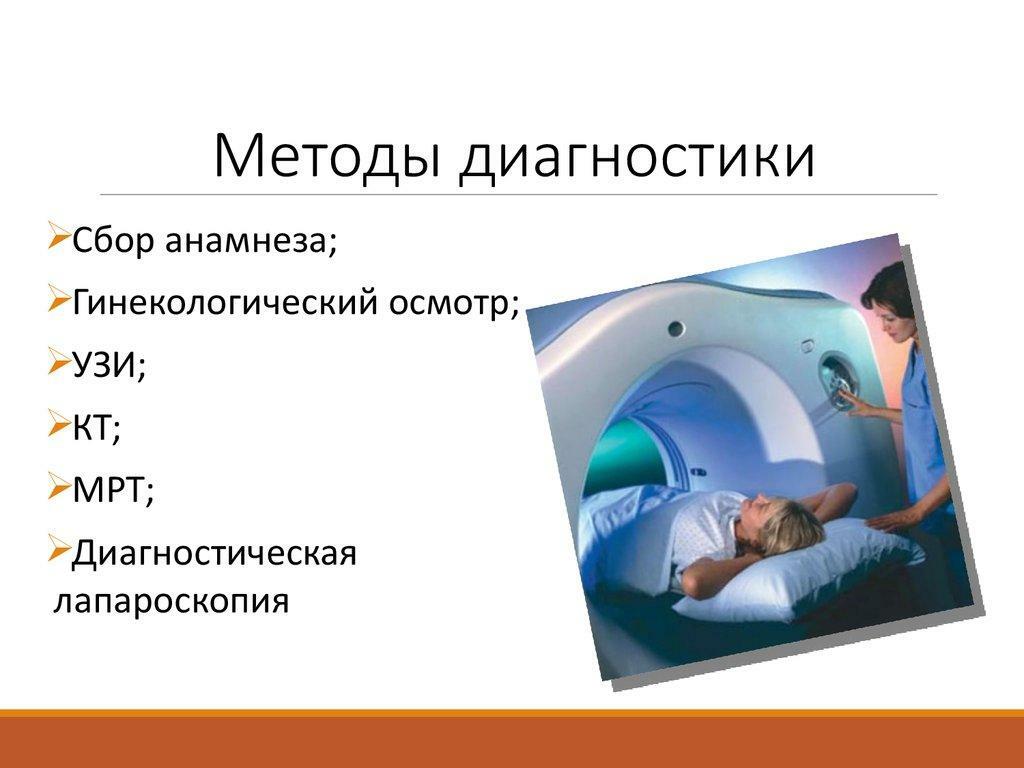Ovarian cyst is a common disease that affects 30 to 50% of women. Usually, such a diagnosis causes patients a real shock, because it involves surgery, a long recovery period, and possibly hormonal problems or the impossibility of conception. But is this affliction really causing such serious consequences, and what is better to choose with this diagnosis: treatment or surgery?

Cyst in the ovary: treatment or operation?
What is an ovarian cyst?
- 5.1 Surgical treatment
- 5.2 Medications
- 5.3 Folk remedies
What is the ovarian cyst?
Ovarian cyst is a formation filled with liquid or semiliquid contents developing on the surface of an organ or in its tissues. It refers to benign tumors and in most cases is diagnosed in women aged 12 to 45-50 years. In the diameter of the cyst may have from 1-2 to 10 or more centimeters in diameter.
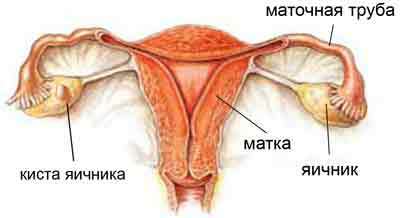
Ovary cyst
There are several varieties of cysts, each of which has its own characteristics.
| Cyst type | Reasons for | Features |
|---|---|---|
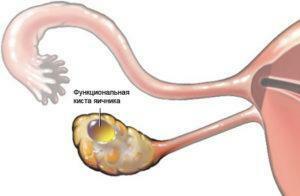 Functional | Development is associated with ovulation and hormonal changes occurring in the body during this period. Varieties - yellow body cyst and follicular | It has a rounded shape, thin walls and a turbid liquid inside. Most often it disappears on its own and requires only medical supervision |
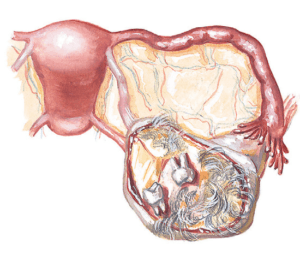 Dermoid | It is formed as a result of a disruption in the formation of tissues that must form the skin, hair and other parts of the embryo. | It is a round formation with thick walls, which has inclusions in the form of different types of tissues. It grows slowly but constantly |
 Endometrioid | Occurs with endometriosis, formed on the surface of the ovary on one side | Small bottle sized, filled with blood with walls of different thicknesses |
 Paraovarial | Grows not from the ovary but from the above appendage | Single-chamber tumor of round / ovalforms, with transparent contents |
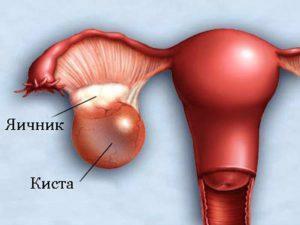 Hemorrhagic | Develops due to hemorrhage into the functional cyst | In appearance resembles functional formation, but with bloody contents inside the |
 Cystic adenoma( cystadenoma) | It is formed directly from the ovarian tissue | A single-chamber tumor localized on one side has a rounded shape and a dense consistency |
Most of the cysts that are diagnosed in women are functional tumors, rarely endometriosis, parovarial, dermoid and cystadenomas.
Symptoms and Diagnosis
Most cysts( especially functional ones) do not give any significant signs, and are diagnosed accidentally during ultrasound or preventive examinations.
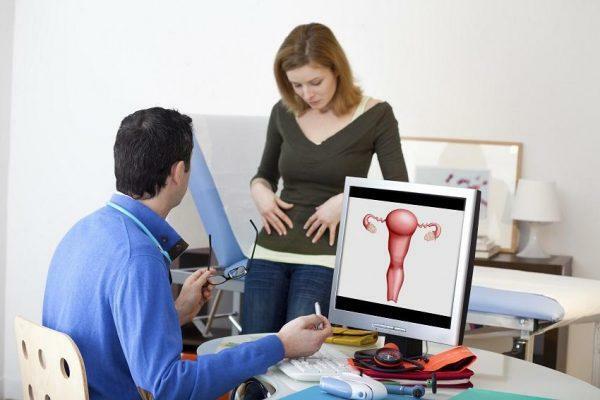
Ovarian cyst is usually diagnosed on a preventive examination
But in some cases a woman can experience the following symptoms:
- pain in the pelvic region and waist( usually blunt or pulling character);
- discharge from the vagina with blood impurities;
- disorders of the menstrual cycle;
- discomfort in the abdomen, which is felt during sexual intercourse or after physical exertion;
- nausea and malaise before menstruation.

Pelvic pain, discomfort, malaise - symptoms of ovarian cyst
If one or more symptoms are detected, a woman needs to undergo a gynecological examination and ultrasound is the simplest and most effective methods of detecting lesions. In order to distinguish the cyst from other tumors, CT and MRI are used to evaluate the condition of the ovaries and nearby organs, and an analysis for cancer markers is used to exclude ovarian cancer.
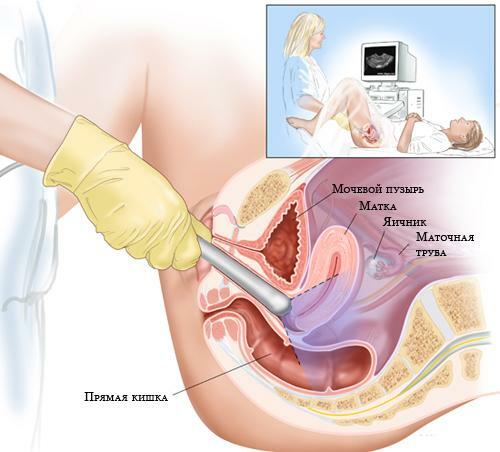
The pelvic ultrasound can be performed in two ways: surface examination and internal
What is a dangerous cyst?
Benthic formations in themselves do not pose a health hazard, but can lead to unpleasant consequences. One of them is the twisting of the leg, with which the cyst is attached to the tissues of the organ. This phenomenon is characterized by severe cutting pains in the abdomen, nausea, vomiting and dizziness, and as a result of complication sepsis of ovarian tissue can develop.
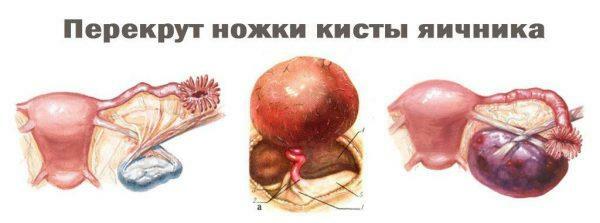
Torsion of the legs of the ovarian cyst
On page Full size
Save
Another dangerous complication is the rupture of the cyst that has similar symptoms and threatens not only the health but also the life of the woman. In addition, some tumors( especially cystoadenomas) tend to malignant, and can cause ovarian cancer.
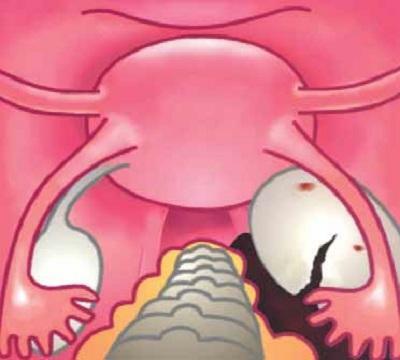
Ovarian cyst rupture
Virtually all cysts are constantly increasing in size, and can reach a weight of 8-10 kg. Such formations are dangerous no more than small cysts, but as they increase they squeeze the organs of the small pelvis and adversely affect their work.
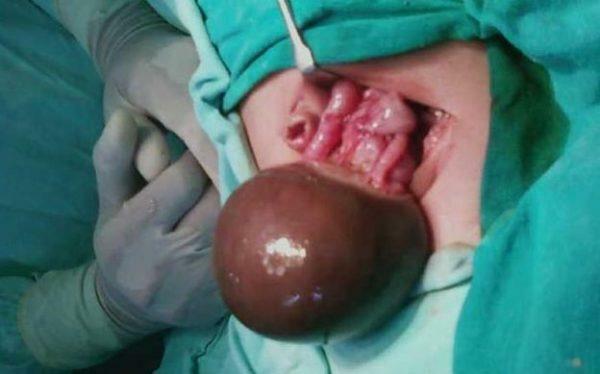
Ovarian cyst removal operation - photo
Ovarian cyst and pregnancy
Ovarian cyst is not a contraindication to pregnancy, but it can significantly complicate the process of conception and lead to secondary infertility. But with adequate and timely treatment, education will not be an obstacle to maternity - even if the doctor had to resort to surgical removal, modern technologies allow to fully preserve the functions of the ovaries.
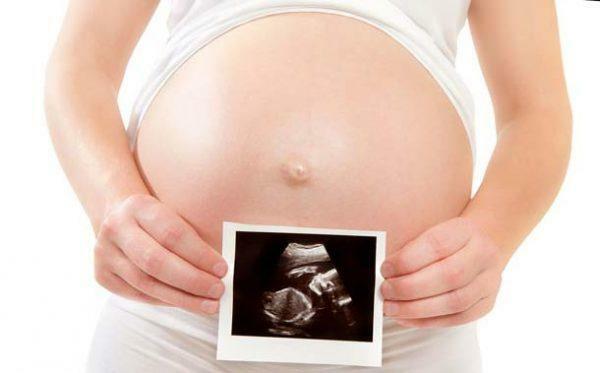
Cyst may appear in a woman on one of the ovaries before or during pregnancy
Treatment of ovarian cyst
Most of the cysts that are found in women are functional formations that do not require special treatment. In this case, the patient is recommended to undergo regular examinations at the gynecologist and do ultrasound to monitor the course of the disease, and sometimes take hormonal medications. Surgical treatment is used only if there are certain indications when the cyst is a potential threat to a woman's health.

Ovarian cyst is treated with different methods
Surgical treatment of
Surgical cysts are removed in the following cases:
- tumor size exceeds 10 cm;
- cyst does not disappear for three consecutive cycles;
- formation caused a complication in the form of torsion, rupture, or hemorrhage;
- there is a risk of malignancy of the tumor.
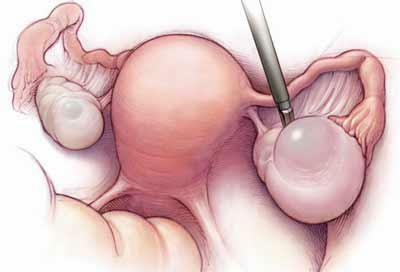
Surgical treatment of cyst
Most often, the formation is removed by laparoscopic means - an abdominal wall is made with a hole, and all manipulations are carried out using a miniature camera. After removal of the tumor, her tissues are sent for histological examination to exclude the cancer tumor. The advantage of laparoscopy is that it allows you to get rid of the cyst without harm to healthy ovarian tissue.
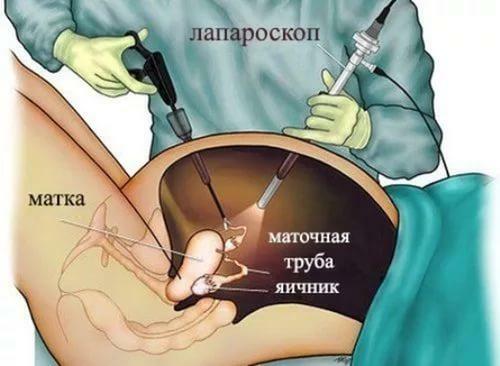
Surgical removal of ovarian cyst
If there are contraindications to laparoscopy or extensive pathological process, the doctor may recommend the following options for operations:
- cystectomy - removal of the capsule of the cyst with preservation of the ovarian tissue;
- wedge resection - excision of the damaged area of the ovary, healthy tissues are also preserved to the maximum extent;
- oophorectomy - complete removal of the ovary;
- adnexectomy - removal of the ovary, epididymis and uterine tube.

Vaginal resection of the ovary
The doctor decides whether to carry out an operation, based on the size of the cyst, its characteristics, the patient's age and other factors.
Medications

Kist can be treated conservatively
Functional cysts most often do not require surgical intervention and are well amenable to conservative treatment - under the influence of drugs they can decrease and even disappear.
Among the contraindications to medical treatment include:
- chronic inflammation of the appendages;
- suspected neoplasm of neoplasm;
- confirmed infertility;
- ruptured cyst accompanied by intrauterine hemorrhage.

Medication is used if there are no contraindications.
For the treatment of cysts, hormonal and anti-inflammatory drugs, sedatives and painkillers, as well as multivitamin complexes are used.
- Hormones. Oral contraceptives( "Diane-35", "Logest", "Zhanin", "Marvelon") are considered the most effective in the therapy of functional ovarian formations. They not only contribute to the reduction of existing cysts, but also hamper the development of new formations.
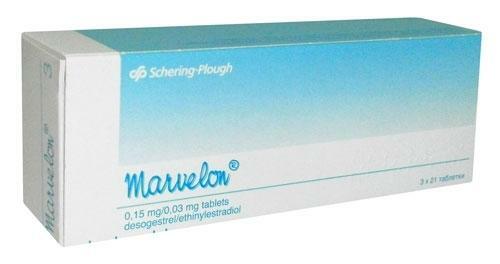
"Marvelon"
- Anti-inflammatory drugs. "Voltaren", "Ibuprofen" and other similar medications are used to prevent possible complications associated with inflammation in the ovaries.
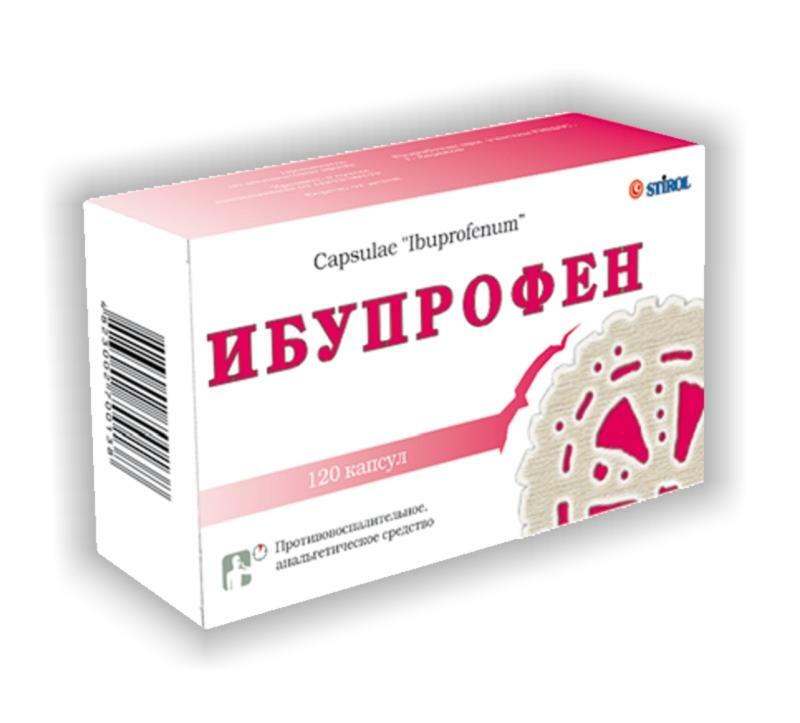
"Ibuprofen"
- Sedative and analgesics. Recommended to eliminate the unpleasant symptoms that accompany the disease: abdominal pain, mood swings, irritability, depression.
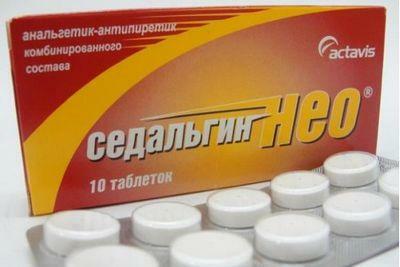
The drug has a strong analgesic, sedative, antipyretic, anti-inflammatory effect.
- Multivitamin Complexes .They are necessary for the restoration of immunity, and they must necessarily include folic acid, vitamins A, C and E.

Vitamins for women
Sometimes medical therapy involves the use of physiotherapy, most often electrophoresis and ultrasound. Charged particles of drugs applied to the electrodes penetrate to the required depth and act directly on the ovarian tissue.
Folk remedies
For the treatment of cysts and other gynecological diseases, the most commonly used are phytohormones - medicinal plants that contain substances that are close in composition to female sex hormones. The most effective of them are the bovine uterus, a red brush and a winter hamster. They are usually taken in a complex according to a certain scheme, so that the effect of one herb enhances the effect of the other.
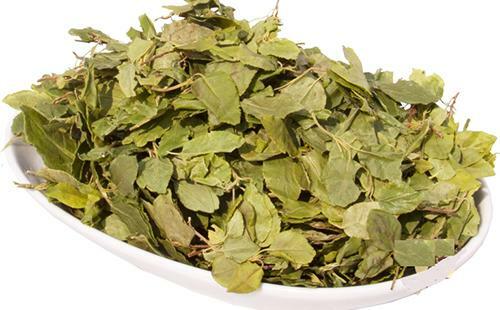
Dry leaf of the ortily

Umbilical umbrella
From the winter garden, the red brush and the hog uterus, prepare the infusions( pour a teaspoon of the herb with a glass of hot water, insist 15-20 minutes, strain).Take the week immediately after the end of menstrual bleeding: the first week - 1/3 cup of bovine uterus infusion three times a day for an hour before meals, the second and third week - infusions of red brushes and wintergreen, respectively, according to the same scheme.
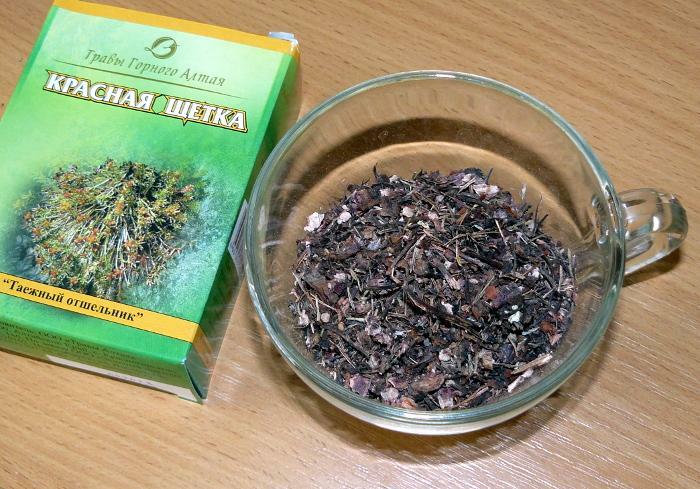
Red brush
No less effective ovarian cyst is treated with burdock juice and dandelion root. Juice of burdock is squeezed from freshly cut leaves and plant roots, taken as follows:
- 1 and 2 days after menstrual bleeding - twice a day in a teaspoon before eating;
- 3 and 4 days - 3 times a day in a teaspoonful;
- from 5 to 1 day following the monthly - three times a day for a tablespoon.

Juice of burdock
From the root of a dandelion it is necessary to prepare water infusion( a teaspoon of chopped root pour a glass of boiling water, insist 15 minutes, strain), drink 1/3 cup twice a day for 5 days before each menses, it is recommended to take 2-3 courses.

Dandelion root
Together with taking medicinal decoctions inside you can use tampons impregnated with propolis, honey, mummies, chaga broth.

Tampon with medicine
Folk remedies in the treatment of ovarian cysts should be used with great care, after consulting with the doctor in charge, as well as regular gynecological examination and ultrasound.
Which method of cyst treatment is more effective?
The question of the effectiveness of this or that method of treatment of the ovarian cyst should only be determined by the doctor after passing the appropriate diagnosis. To be engaged in a selftreatment in this case it is extremely not recommended, as it can grease a picture of disease and cause serious complications.


